► How an electric car is serviced
► Maintaining our Abarth 500e
► Read month 1 here
Have you ever wondered what happens when an electric car needs a service? Judging from Google search data, many Brits think EVs don’t ever need maintenance, which is mildly worrying. So when the warning light flashed up on our Abarth’s dashboard, that triggered a dive into the topic. Just what is it that mechanics do when they service a car with no engine?
We were surprised how early the 500e needed its first round of maintenance. A scant 4311 miles were showing on the odometer, but a look in the manual confirmed that the all-electric hot hatch does indeed need an inspection annually or after 9000 miles, whichever comes soonest – exactly the same service intervals as its combustion equivalent.
It’s perhaps a reflection of the small battery and limited range of the Abarth that it had done little more than 4000 miles in the year since it was registered.
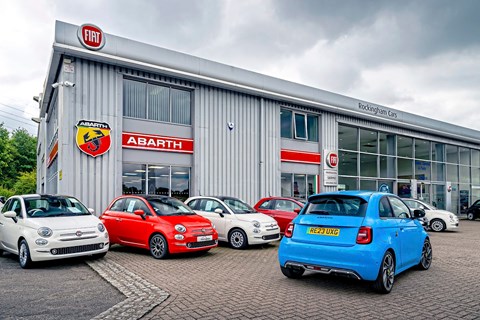
We booked in to our local franchised dealership, Rockingham Cars in Corby (above). It’s one of the UK’s biggest Abarth outlets and an established family-run business led by owner and managing director Matt Hall, who took over from his father David four years ago. He agreed to let us chronicle the maintenance procedure and explain the differences between caring for a petrol and all-electric 500.
The dealership sells and services a growing number of EVs, so they’ve trained staff and upgraded their facilities to cope. Rockingham has installed 10 AC chargers rated at 22kW, powered predominantly by banks of solar panels recently installed on the roof. ‘On sunny days, we can charge everything for free,’ beams Hall. They’re considering a more rapid DC charger but don’t believe it’s necessary yet.
Servicing an EV is quicker and easier than a combustion Abarth. This is happily reflected in the cost: our visit would take less than an hour if we didn’t have a photographer in tow and that’s why it costs just £98 for a minor service on a 500e, or £195 for a major.
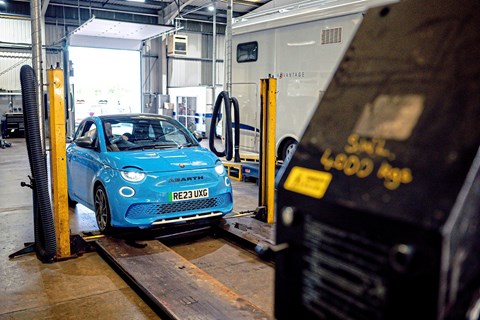
A petrol-supping Abarth hot hatch, for comparison, would cost £195 and £425 respectively – so the EV comes in at around half the price. It’s a handy saving for the consumer, though a worry for the trade. ‘We’re not making the same margin on EV servicing,’ admits the boss. ‘We’re modelling what this means moving forwards and are considering more aftermarket work and services such as while-you-wait power upgrades. The world of servicing is changing fast.’
Master technician Tom Borland is our guide for the day, explaining every step of the inspection. This veteran engineer, who has been high-voltage trained, drives our Poison Blue hot hatch on to one of two dedicated, heavy-duty EV ramps ready to receive some TLC. ‘Many parts of servicing an EV are the same as for a combustion equivalent,’ he tells us. But there are fewer moving parts, and the powertrain requires less attention.
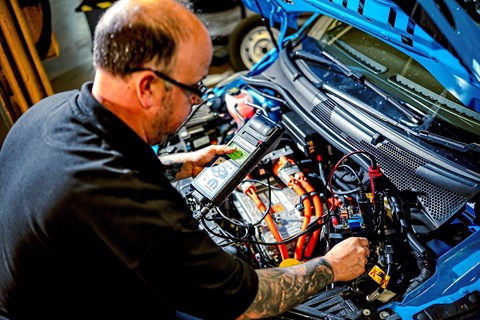
He starts by checking the 12-volt battery (above), the smaller ancillary power source that can leave an EV stranded if it runs flat, even when the main battery is fully charged. Ours passes its health check with flying colours and Borland moves on to check the fluids, topping up the screenwash and ensuring the coolant and brake fluid levels are fine.
Next the car is hoisted up to check the bits you can’t see without being underneath.
A bright torch is shone underneath to inspect the condition of the battery and the undertray. Borland is checking for any signs of damage to the cells, which would spell serious trouble, but he points out that most EVs he services are unscathed. ‘You’d have to beach it on something very hard to damage the main battery.’
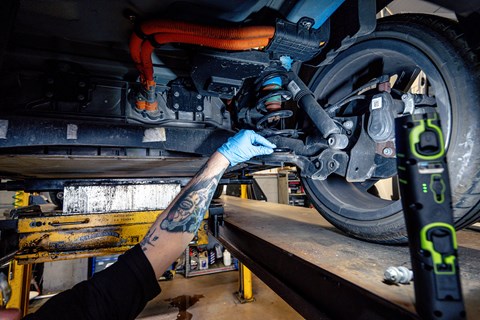
He’s also looking at the suspension, checking the chassis alignment, and assessing the tyres and brakes for condition, wear and pressure. One EV he services is still on its original tyres after 40,000 miles, he says. ‘That’s a driving instructor’s car – not all electric cars wear their tyres out quickly.’ My car is brought back to earth and the technician plugs into the onboard diagnostics to look for error codes. Our Abarth is pleasingly glitch-free, so he clears the service reminder, resets the tyre-pressure monitor and checks for any updates available. This is all done via a tablet in his hand, connected to the OBD port in the driver footwell.
Borland also has to deal with three recall actions listed on our car: the Abarth logos on the flank can work loose (ours are not), the rear right coil spring can rub the cup on the bottom suspension arm (ours isn’t) and the headlamp bezel bracket under the bonnet can crack (ours is, so a new part is ordered under warranty).
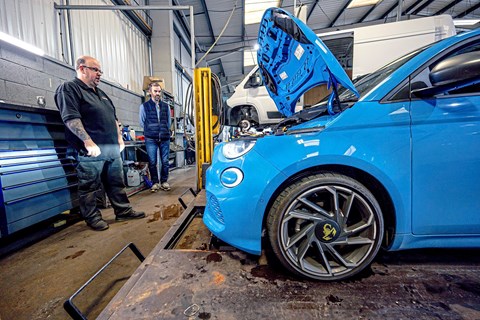
A quick road test and a wash, and the first service is complete. It’s all remarkably unremarkable. We pay up, thank the friendly, helpful staff and drive off past the final consignment of petrol Abarths that have just been delivered to Rockingham Cars. And that, in one neat juxtaposition, reflects the transformation currently rebooting the British car market.
Catch up on earlier instalments of our Abarth 500e long-term test here:
Read month 1
Read month 2
Read month 3
Read month 4
Logbook: Abarth 500e Turismo
Price: £38,195 (£38,795 as tested)
Performance: 42kWh battery, e-motor, 152bhp, 7.0sec 0-62mph, 96mph
Efficiency: 3.3 miles per kWh (official), 3.5 miles per kWh (tested), 0g/km CO2
Range: 158 miles (claimed), 147 miles (tested)
Energy cost: 7.7p per mile
Miles this month: 505
Total miles: 4803
With thanks to Rockingham Cars for their help with this photoshoot. CAR magazine paid for the service